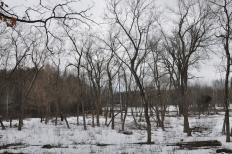






 Although March 20 marked the arrival of the spring equinox, Madison is still shivering in cold temperatures. According to the National Weather Service Offices, the average temperature on March 20 was 15 degrees this year, while the same day last year reached 71 degrees.
Although March 20 marked the arrival of the spring equinox, Madison is still shivering in cold temperatures. According to the National Weather Service Offices, the average temperature on March 20 was 15 degrees this year, while the same day last year reached 71 degrees.
“We got snow covering the ground for a longer period than normal, and we still have it now,” said Levi Wood, a naturalist at UW Arboretum, after guiding a public tour titled “End of Winter” in the Arboretum on Sunday, March 24. That day turned out windy and snowy, with a high temperature of 31 degrees.
“This is becoming one of the longer lasting, snowier winters any of us can remember,” wrote Wood in the trip’s note on the Arboretum website.
In the freezing wintry air, a few species still surfaced to herald the spring in Madison, including the skunk cabbage, a plant distributed near the Wingra Woods in the Arboretum.
Skunk cabbage, said Wood, is “a very unique plant … able to come up much earlier than other plants.”
It absorbs solar energy, emanates heat as it grows, and melts the snow around it.
“If you go down to the Skunk Cabbage Bridge [in the Arboretum], you can see … all the snow is gone in between the skunk cabbage plants,” said Wood.
Another sign of spring, added Wood, is within the maple tree.
“I talked to people who are tapping maples trees for maple syrup, and they said the sap is flowing,” said Wood.
He also observed on silver maple trees, “the buds are bigger and turn bright red,” signaling that “the spring is coming, and they are ready to blossom.”
Migratory birds are coming back from southern regions, including the American robin and the red-winged blackbird, said Wood. He recalled seeing groups of robins on top of trees in the morning of March 24, noting “two weeks ago you wouldn’t see any.”
Great blue herons also start returning from winter habitats in the spring. These birds don’t go too far in the winter, said Wood, citing southern Illinois and the Mississippi river as likely destinations. Herons wade in open waters, hunting for fish and frogs. Though the lakes around Madison are still covered with ice, the Yahara River provides open water for the birds.
A night walk on Saturday, March 23 seeking the woodcock in the Arboretum turned out to be a futile search.
“[Woodcock] would normally be here now, but it is not here yet,” said Wood.
As a shorebird, the woodcock feeds in the mud, probes inside the moist soil with its long beak searching for worms and insects. Since much of the ground was still frozen, Wood said he thought woodcocks wouldn't appear until the ground thaws in April.
Spring also awakens hibernating animals. Chipmunks, which have been hiding in underground tunnels and consuming its food store throughout the winter, appear “almost always before the end of March,” said Wood.
Wood said he saw one chipmunk earlier that week (around March 19), but suspected the animal returned underground to await warmer temperatures.
Accompanying the thawing ground, Wood predicts a variety of woodland wildflowers will show up in April, such as Dutchman’s breeches, toothwort, hepatica, and spring beauties.
These wildflowers in the woods strategically emerge early in spring while trees are almost leafless, said Wood. By the end of May and June, when trees’ leaves stretch above and block the sunlight, these species will have already finished the cycle of flowering and seeding, explained Wood.
“They are just spring plants,” said Wood.
|
|
|
Welcome to the Madison Commons, a website designed to provide news and information about all of Madison's neighborhoods and a crossroads for the discussion of community issues. The name comes from the idea of a village commons, a place for news, talk, debate, and some entertainment, too, that's open to everyone.
All rights reserved. Read more about the Madison Commons and its partners.

